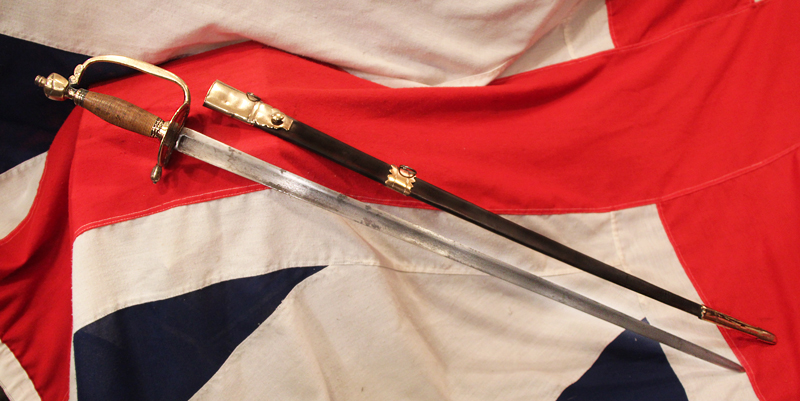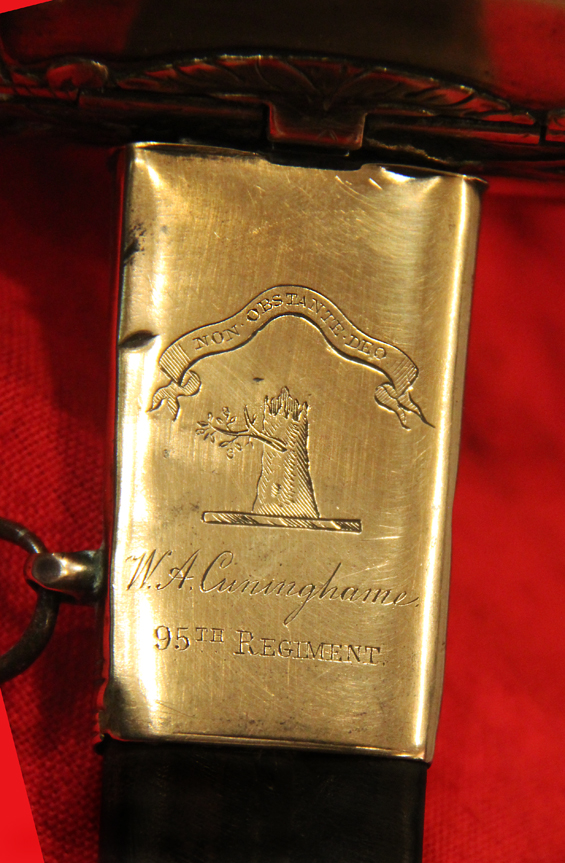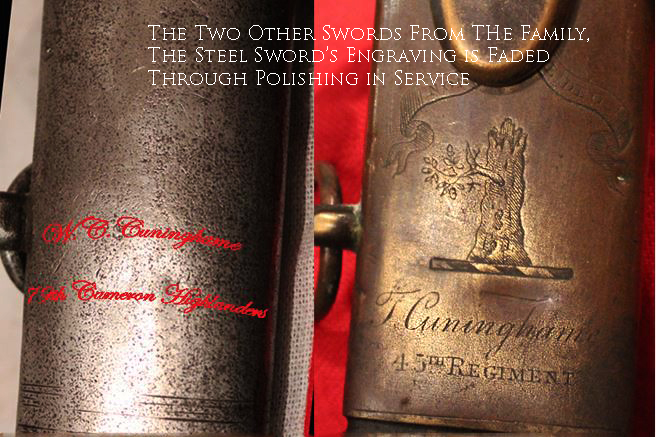A Stunning, Historical, Napoleonic War’s Period, 1796 Pattern Officer's Combat Sword of William A. Cuninghame, of the 95th
It’s rarity value is due to both it’s known specific history to a Napoleonic Wars family member and it’s condition.
With superb provenance, that is very rare to survive. He was the father of Capt William Cuninghame Cuninghame, hero of the 79th Foot in the Crimean War, and brother of Capt. Thomas Cuninghame of the 45th Foot. One of all three original family swords, owned and used in combat by William Cunningham senior, all with their own built in provenance, from the world renown British Army, serving in the 95th, 45th and the 79th Regiments. All three were acquired, then expertly conserved by us.
They were obtained by us from a direct line family descendant, still possessor of the same family name, and they are all all offered for sale by us separately, but the light infantry sabre of the 45th regiment is now sold. A super, antique and historical, officers combat sword of his ancestor, who fought with distinction in the Napoleonic Wars era. Each sword is engraved with the family name, crest, and motto. This sword, belonged to William Alexander, Cuninghame, who joined his regiment as a junior officer in April 1813, and served as an officer in the 95th regt., Another sword belonged, and was used, by Thomas Cuninghame, William Alexander's elder brother, who served in the 45th regt., both used by them in the Napoleonic Wars, and a basket hilted broadsword which we have also fully conserved, that was used by William Alexander Cuninghame's son, Capt. William Cuninghame Cuninghame, in the Crimean War. According to family record, W.A.Cuninghame while serving with his regiment was wounded in Guadaloupe in 1814, but this may well have been early 1815, during the British invasion to retake the island in Napoleon's Hundred Days period. The Hundred Days war was so called after Napoleon returned from exile in Elba, reformed his army, declared war on the allies, and that culminated in the Battle of Waterloo in Belgium, Wellington's great victory and Napoleon's final defeat. The 1796 Pattern British Infantry Officers Sword was carried by officers of the line infantry in the British Army between 1796 and the time of its official replacement with the gothic hilted sword in 1822. This period encompassed the whole of the Napoleonic Wars.
The Napoleonic Wars, was a series of wars between Napoleonic France and shifting alliances of other European powers that produced a brief French hegemony over most of Europe. Along with the French Revolutionary wars, the Napoleonic Wars constitute a 23-year period of recurrent conflict that concluded only with the Battle of Waterloo and Napoleon’s defeat by Wellington, and thus his subsequent second abdication on June 22, 1815. It is interesting that statistically Napoleon had fought and won more battles than the worlds next three great military commanders combined, however, despite his obvious genius he never actually won a war, and Wellington had never lost one.
France had a population of 27,350,000 in 1801 as opposed to Great Britain’s 10,942,146, outnumbering Britain almost three to one, and France had gained much territory warfare since 1792. However, a significant advance in economic strength was to enable Great Britain to wage war against this formidable adversary and to achieve the “miracles of credit” whereby foreign military assistance could be subsidized. The French, whose manufactures progressed less dramatically than the British and whose seaborne trade had been strangled by the superior nature of Britain’s navy, found it impossible to raise funds commensurate with their aggressive policy in Europe, so that Napoleon had to rely on the spoils of conquest and looting to supplement the deficiencies of French finance. As a matter of course, Wellington had forbade his armies to engage in looting of any kind, upon penalty of severe flogging or worse.
The Napoleonic Wars
The Napoleonic Wars were massive in their geographic scope, ranging, as far as Britain was concerned, over all of the five continents. They were massive, too, in terms of expense. From 1793 to the Battle of Waterloo in June 1815 the wars cost Britain more than £1,650,000,000. Only 25 percent of this sum was raised by government loans, the rest coming largely from taxation, not least from the income tax that was introduced in 1798. But the wars were massive most of all in terms of manpower. Between 1789 and 1815 the British army had to expand more than sixfold, to about a quarter of a million men. The Royal Navy, bedrock of British defence of its trade, and empire, grew further and faster still. Before the wars it had employed 16,000 men; by the end of them, it employed more than 140,000. Because there was an acute danger between 1797 and 1805 that France would invade Britain, the civil defense force also had to be expanded. The militia was increased, and by 1803 more than 380,000 men were acting as volunteers in home-based cavalry and infantry regiments. In all, one in four adult males in Britain may have been in uniform by the early 19th century.
This sword’s design was introduced by General Order in 1796, replacing the previous 1786 Pattern. It was similar to its prececesor in having a spadroon blade, i.e. one straight, flat backed and single edged with a single fuller on each side. The hilt gilt brass with a knucklebow, vestigial quillon and a twin-shell guard somewhat similar in appearance to that of the smallswords which had been common civilian wear until shortly before this period. The pommel was urn shaped and, in many later examples, the inner guard was hinged to allow the sword to sit against the body more comfortably and reduce wear to the officer's uniform.
Code: 21865
4750.00 GBP







